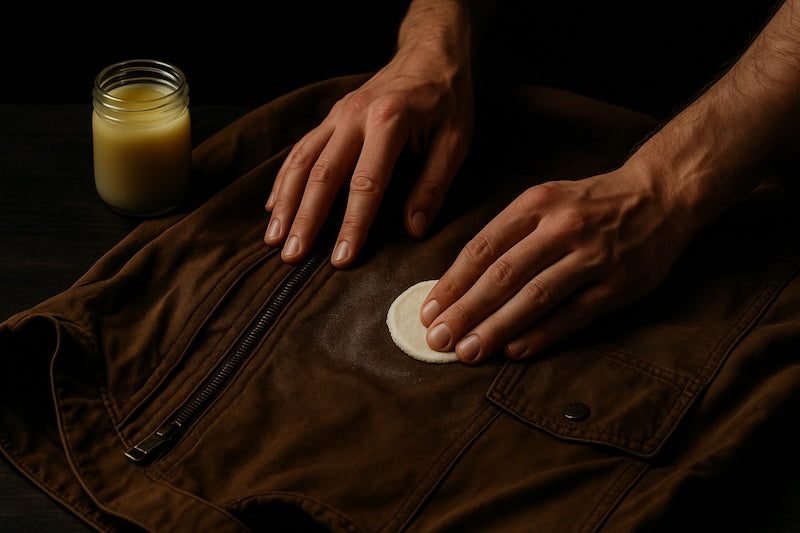Make It Weather the Storm
A well-made canvas jacket has character — the kind that grows richer with every season, every wrinkle, every mark of use. But while cotton canvas is tough and breathable, it’s not inherently waterproof. When the skies turn grey and you still want to wear your favourite jacket, a bit of old-school craftsmanship can make all the difference.
With a few simple, planet-friendly ingredients, you can make your own natural waterproofing wax — one that protects your jacket from rain, revives its colour, and develops a patina that no synthetic coating can imitate.
Why Waterproof Naturally?
Waterproofing isn’t new — sailors, explorers, and ranchers have been doing it for centuries. What’s changed is how it’s done. Today, many modern “waterproof” jackets rely on synthetic coatings (like polyurethane, acrylics, or PFC-based membranes) that make fabrics water-repellent but also turn them into plastic films.
The problem?
-
These synthetics shed microplastics every time they’re worn or washed.
-
The coatings wear out quickly and can’t be renewed, leading to premature disposal.
-
They’re often non-biodegradable and derived from fossil fuels.
In contrast, a natural canvas jacket can be rewaxed endlessly. It breathes, ages beautifully, and when made from pure cotton or hemp, it returns harmlessly to the earth.
By waxing it yourself, you’re not just waterproofing — you’re prolonging its life and preserving its soul.
Ingredients for Your DIY Wax
| Ingredient | Purpose | Approx. Quantity |
|---|---|---|
| Beeswax | Main waterproofing and stiffening agent | 1 part |
| Carnauba Wax (optional) | Adds hardness, sheen, and durability | ¼ part |
| Boiled Linseed Oil | Helps soften the wax and improves spreadability | ½ part |
| Coconut or Jojoba Oil | Adds flexibility and nourishment | ¼ part |
| Cedarwood Essential Oil (10–15 drops per 250 ml batch) | Neutralizes raw linseed odor and adds a warm, woody scent | Optional but highly recommended |
💡 Tip: If you prefer an even more natural scent, you can swap cedarwood for sandalwood or pine essential oil — both complement the earthy smell of waxed canvas.
What You’ll Need
-
Double boiler or metal bowl over simmering water
-
Wooden stir stick or spoon
-
Clean lint-free cotton cloth or sponge
-
Hair dryer or heat gun (for setting the wax)
-
Your dry, clean canvas jacket
Step-by-Step: Crafting the Wax
1. Melt the Waxes
Chop or grate your beeswax and carnauba wax.
In your double boiler, melt them together gently over low heat — never directly on the flame. Stir occasionally until the mixture becomes a clear liquid.
2. Add the Oils
Pour in the boiled linseed and coconut (or jojoba) oil while stirring slowly.
Continue until the mixture turns smooth and glossy — it should have the consistency of warm honey.
3. Scent and Cool
Turn off the heat, let it cool slightly, then add your cedarwood essential oil. Stir well.
The result should be a semi-soft balm that smells like a pine forest after rain.
4. Test and Apply
Once cool enough to handle, test a small amount on the inside hem of your jacket.
If it spreads easily without darkening too much, proceed to apply it across the entire surface using circular motions. Focus on seams, shoulders, elbows, and cuffs.
5. Set the Wax
Use a hair dryer or heat gun on low to melt the wax deeper into the fabric fibres.
You’ll notice the jacket darken slightly — that’s the wax bonding. Let it cure overnight in a warm, dry place.
6. Check the Waterproofing
After curing, sprinkle or spray a little water onto the surface. If you’ve done it right, the water should form beads that sit proudly on the fabric instead of soaking in. See below.

How It Works
Beeswax fills the tiny gaps between cotton fibres, creating a water-resistant barrier that keeps out rain while letting the fabric breathe. Linseed and natural oils condition the fibres, preventing stiffness or cracking.
The result: a durable, flexible, water-shedding surface that looks and feels organic — unlike the plastic-coated surface of synthetic jackets.
Why This Beats a Synthetic Waterproof Jacket (IMHO)
| Aspect | DIY Waxed Canvas | Synthetic Waterproof Jacket |
|---|---|---|
| Material Base | Natural cotton or hemp canvas | Petroleum-derived polyester/nylon |
| Waterproofing Method | Beeswax + natural oils | Plasticised coatings (PU, PVC, PFC) |
| Breathability | Excellent – allows vapor to escape | Limited – traps sweat, causes clamminess |
| Repairability | Can be rewaxed and renewed indefinitely | Difficult – once coating cracks, it’s done |
| End-of-Life | Biodegradable or recyclable | Non-biodegradable, landfill-bound |
| Environmental Footprint | Low, natural inputs | High carbon footprint and microplastic shedding |
| Aesthetic Over Time | Ages with a rich patina | Peels, flakes, and loses function |
In short, synthetic waterproof jackets are a shortcut — they offer quick protection but age poorly. Waxed canvas, on the other hand, evolves — every crease and scuff adds personality. It’s the difference between a disposable gadget and a handcrafted tool that gets better with use.
Aftercare & Maintenance
-
Re-wax once or twice a year, or when water stops beading on the surface.
-
Clean gently with a damp cloth — avoid detergents, as they strip the wax.
-
Store in a cool, dry place and avoid direct sunlight for long durations.
-
If the surface looks patchy, simply warm it slightly and smooth the wax with your hand.
Over time, your jacket will develop that signature matte sheen — a look that modern synthetics spend fortunes trying to replicate, but never quite achieve.
When you wax your own jacket, you’re not just making it waterproof — you’re becoming part of a tradition that values self-reliance, sustainability, and craft.
Each pass of the cloth, each stroke of wax, brings you closer to your garment — and further away from the throwaway habits that define fast fashion.
So the next time rain clouds gather, step out in your weatherproofed canvas — not just protected from the storm, but at peace with it.






Share:
What Does Sustainable Fashion Really Mean?
The Truth About Microplastics